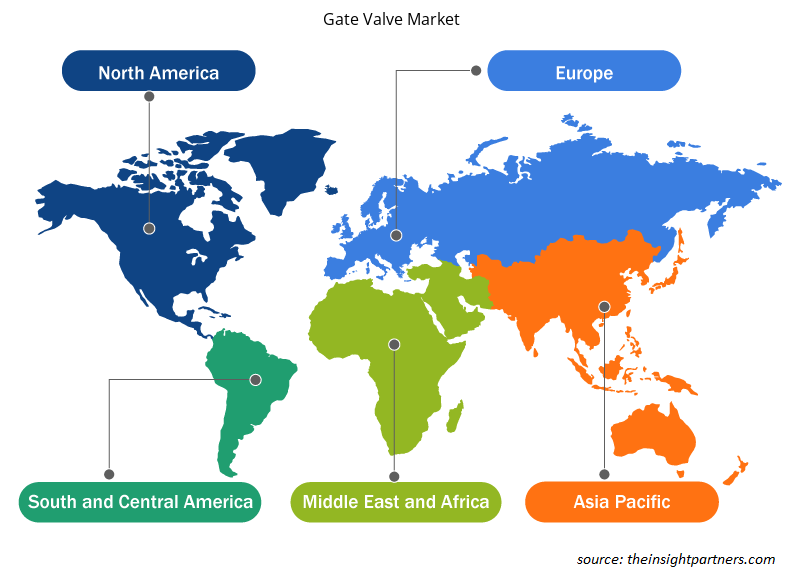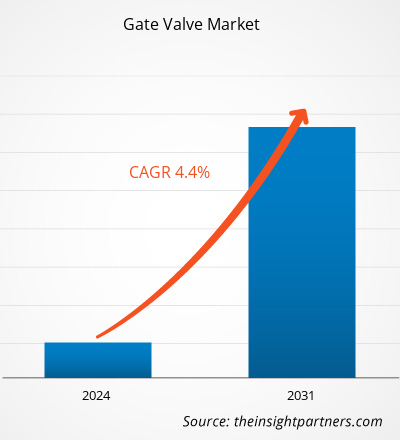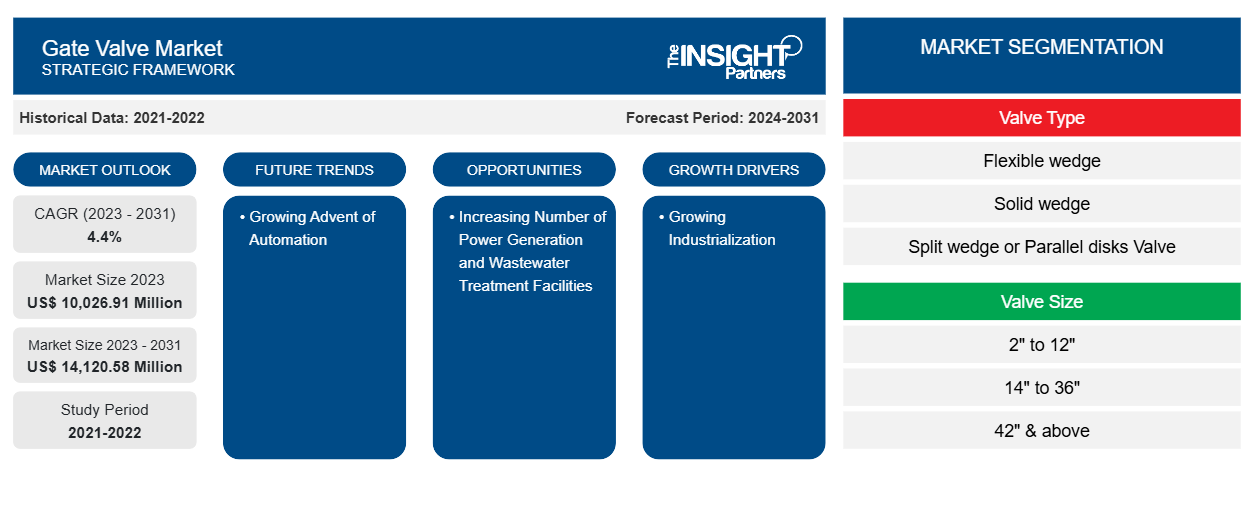Der Markt für Schieberventile soll von 10.026,91 Millionen US-Dollar im Jahr 2023 auf 14.120,58 Millionen US-Dollar im Jahr 2031 anwachsen. Der Markt wird zwischen 2023 und 2031 voraussichtlich eine durchschnittliche jährliche Wachstumsrate von 4,4 % verzeichnen. Die zunehmende Zahl von Kraftwerken und Abwasseraufbereitungsanlagen dürfte ein wichtiger Trend auf dem Markt bleiben.
Marktanalyse für Schieberventile
Die Schieber werden auch in Niederdruckanwendungen als Industriearmaturen eingesetzt. Wasser, Dampf, Gase und andere vergleichbare Flüssigkeiten mit geringer Korrosion, Wasserstoffgemische und aggressive Medien sind allesamt mögliche Arbeitsmedien für diese Keilschieber. Absperrventile sind die Hauptfunktion dieser Schieber. Schieber werden in verschiedenen mechanischen Geräten eingesetzt, darunter in HLK- und Wassersystemen am Arbeitsplatz und im Benzinmotor eines Autos. Darüber hinaus sind Schieber in Privathaushalten und Gewerbeanlagen weit verbreitet und werden für verschiedene Zwecke eingesetzt. Diese Ventile werden aus verschiedenen Materialien hergestellt, darunter Edelstahl, Gusseisen, legierter Stahl, Schmiedestahl und andere.
Marktübersicht für Schieberventile
Zu den wichtigsten Akteuren im globalen Ökosystem des Schiebermarkts zählen Rohstofflieferanten, Schieberhersteller und Endverbraucher. Die steigende Nachfrage nach Schiebern in Fertigungsanlagen verschiedener Branchen ist einer der Hauptfaktoren, die die Nachfrage nach Schiebern antreiben. Die Rohstofflieferanten bieten Rohstoffe wie Stahl, Eisen und Aluminium für verschiedene Schiebertypen an, wie z. B. flexible Keile und Vollkeile. Darüber hinaus beeinflusst die Verwendung von Schiebern durch Endverbraucher zur Bereitstellung der erforderlichen Geschwindigkeit, Beschleunigung und Verzögerung von Flüssigkeiten für die Industrieanlagen die Nachfrage nach Schiebern weiter.
Passen Sie diesen Bericht Ihren Anforderungen an
Sie erhalten kostenlos individuelle Anpassungen an jedem Bericht, einschließlich Teilen dieses Berichts oder einer Analyse auf Länderebene, eines Excel-Datenpakets sowie tolle Angebote und Rabatte für Start-ups und Universitäten.
-
Holen Sie sich die wichtigsten Markttrends aus diesem Bericht.Dieses KOSTENLOSE Beispiel umfasst eine Datenanalyse von Markttrends bis hin zu Schätzungen und Prognosen.
Markttreiber und Chancen für Schieberventile
Zunehmende Industrialisierung begünstigt Marktwirtschaft
Die Regierungen verschiedener Industrieländer wie der USA haben verschiedene Initiativen ergriffen, um den Industriesektor des Landes zu unterstützen. Die Regierungsinitiativen bieten den in der Region ansässigen Industrieunternehmen verschiedene Vorteile und treiben das Wachstum des Industriesektors des Landes voran. Dadurch wird das Marktwachstum beeinflusst. Die hohe Präsenz von in Europa ansässigen Fertigungsunternehmen profitierte von den dort vorhandenen entwickelten Einrichtungen. Eine starke Wirtschaft ermöglicht es den Unternehmen, mehr für Innovationen auszugeben, die das Wachstum neuer Technologien fördern. Erhebliche Investitionen können dem Schieberventilmarkt weltweit mehr Wachstum bescheren.
Wachsende Zahl von Kraftwerken und Abwasseraufbereitungsanlagen
Die entwickelten Regionen freuen sich darauf, eine breite Palette von Wasseraufbereitungs- und Stromerzeugungsanlagen einzuführen. Außerdem ergreifen mehrere Unternehmen in der Region strategische Initiativen und investieren in fortschrittliche Technologien, was den Markt für Schieberventile weiter ankurbelt. Das technologische Ökosystem in Nordamerika und Europa ist fortgeschritten. Die entwickelten Regionen konzentrieren sich auf Investitionen in fortschrittliche Technologien. Zum Beispiel hat Veolia Water Technologies stark in tragbare Wasseraufbereitungstechnologien investiert und große Probleme mit einem Wasserlösungsspezialisten gelöst und eine Reihe von Notfalldiensten für das Ausfallzeitmanagement angeboten, was voraussichtlich den Einsatz der Schieberventile vorantreiben wird. Darüber hinaus führt der steigende Energiebedarf auch zu einer wachsenden Nachfrage nach Stromerzeugungsanlagen, was den Markt für Schieberventile in den kommenden Jahren ebenfalls positiv beeinflussen wird.
Segmentierungsanalyse des Marktberichts für Absperrschieber
Wichtige Segmente, die zur Ableitung der Marktanalyse für Schieberventile beigetragen haben, sind Ventiltyp, Ventilgröße und Anwendung.
- Basierend auf dem Ventiltyp ist der Markt für Schieberventile in flexible Keil-, Vollkeil-, geteilte Keil- oder Parallelscheibenventile unterteilt. Das Vollkeilsegment hatte im Jahr 2023 einen größeren Marktanteil.
- Basierend auf der Ventilgröße ist der Markt für Schieberventile in 2" bis 12", 14" bis 36" und 42" und mehr unterteilt. Das Segment 14" bis 36" hatte im Jahr 2023 einen größeren Marktanteil.
- Nach Anwendung ist der Markt in Öl und Gas, Wasser- und Abwasseraufbereitung, Chemie und andere unterteilt. Das Öl- und Gassegment hielt im Jahr 2023 einen bedeutenden Marktanteil.
Marktanteilsanalyse für Schieberventile nach geografischer Lage
Der geografische Umfang des Marktberichts für Absperrschieber ist hauptsächlich in fünf Regionen unterteilt: Nordamerika, Asien-Pazifik, Europa, Naher Osten und Afrika sowie Süd- und Mittelamerika.
Der asiatisch-pazifische Raum ist Marktführer. Der asiatisch-pazifische Raum ist eine dicht besiedelte Region der Welt mit einem höheren Energiebedarf. Die Region ist bei der Energieerzeugung extrem abhängig von fossilen Brennstoffen, und um diese Abhängigkeit zu verringern, investieren Länder wie China, Indien, Japan und Australien stark in Projekte für erneuerbare Energien. Tatsächlich ist China der größte Produzent und verfügt über die größte Windenergieanlage der Welt. Die wachsende Zahl von Anlagen zur Erzeugung erneuerbarer Energie ist ein wichtiger Treiber für den Markt für Schieber. Ebenso hat die wachsende Zahl von Wasser- und Abwasseraufbereitungsanlagen auf der ganzen Welt einen erheblichen positiven Einfluss auf die Schieberindustrie.
Regionale Einblicke in den Markt für Absperrschieber
Die regionalen Trends und Faktoren, die den Markt für Schieberventile im Prognosezeitraum beeinflussen, wurden von den Analysten von Insight Partners ausführlich erläutert. In diesem Abschnitt werden auch die Marktsegmente und die Geografie von Schieberventilen in Nordamerika, Europa, im asiatisch-pazifischen Raum, im Nahen Osten und Afrika sowie in Süd- und Mittelamerika erörtert.

- Erhalten Sie regionalspezifische Daten zum Markt für Absperrschieber
Umfang des Marktberichts über Absperrschieber
| Berichtsattribut | Details |
|---|---|
| Marktgröße im Jahr 2023 | 10.026,91 Millionen US-Dollar |
| Marktgröße bis 2031 | 14.120,58 Millionen US-Dollar |
| Globale CAGR (2023 - 2031) | 4,4 % |
| Historische Daten | 2021-2022 |
| Prognosezeitraum | 2024–2031 |
| Abgedeckte Segmente |
Nach Ventiltyp
|
| Abgedeckte Regionen und Länder |
Nordamerika
|
| Marktführer und wichtige Unternehmensprofile |
|
Marktteilnehmerdichte: Der Einfluss auf die Geschäftsdynamik
Der Markt für Schieberventile wächst rasant, angetrieben durch die steigende Nachfrage der Endnutzer aufgrund von Faktoren wie sich entwickelnden Verbraucherpräferenzen, technologischen Fortschritten und einem größeren Bewusstsein für die Vorteile des Produkts. Mit steigender Nachfrage erweitern Unternehmen ihr Angebot, entwickeln Innovationen, um die Bedürfnisse der Verbraucher zu erfüllen, und nutzen neue Trends, was das Marktwachstum weiter ankurbelt.
Die Marktteilnehmerdichte bezieht sich auf die Verteilung der Firmen oder Unternehmen, die in einem bestimmten Markt oder einer bestimmten Branche tätig sind. Sie gibt an, wie viele Wettbewerber (Marktteilnehmer) in einem bestimmten Marktraum im Verhältnis zu seiner Größe oder seinem gesamten Marktwert präsent sind.
Die wichtigsten auf dem Markt für Absperrschieber tätigen Unternehmen sind:
- BRAY INTERNATIONAL
- DEZURIK, INC.
- EMERSON ELECTRIC CO.
- ITT INC.
- MUELLER CO. LLC
- ORBINOX
Haftungsausschluss : Die oben aufgeführten Unternehmen sind nicht in einer bestimmten Reihenfolge aufgeführt.

- Überblick über die wichtigsten Akteure auf dem Markt für Schieberventile
Neuigkeiten und aktuelle Entwicklungen zum Schiebermarkt
Der Markt für Schieberventile wird durch die Erhebung qualitativer und quantitativer Daten nach Primär- und Sekundärforschung bewertet, die wichtige Unternehmensveröffentlichungen, Verbandsdaten und Datenbanken umfasst. Nachfolgend sind einige der Entwicklungen auf dem Markt für Schieberventile aufgeführt:
- Mueller hat ein bidirektionales Absperrventil Pratt P77 mit Außensitz für industrielle Anwendungen auf den Markt gebracht. (Quelle: Mueller Co. LLC, Pressemitteilung, September 2023)
- ORBINOX hat ein bidirektionales Hochdruck-Plattenschieberventil vorgestellt, das in erster Linie für industrielle Anwendungen und Wasseraufbereitungsanwendungen entwickelt wurde. Sein Design konzentriert sich darauf, eine perfekte Lösung für Wasseraufbereitungsanwendungen und allgemeine industrielle Prozesse zu bieten, die Hochdruckleistung und Zuverlässigkeit erfordern. (Quelle: ORBINOX, Pressemitteilung, Januar 2022)
Marktbericht zu Absperrschiebern – Abdeckung und Ergebnisse
Der Bericht „Marktgröße und Prognose für Schieberventile (2021–2031)“ bietet eine detaillierte Analyse des Marktes, die die folgenden Bereiche abdeckt:
- Marktgröße und Prognose für Schieberventile auf globaler, regionaler und Länderebene für alle wichtigen Marktsegmente, die im Rahmen des Berichts abgedeckt sind
- Markttrends für Schieberventile sowie Marktdynamiken wie Treiber, Einschränkungen und wichtige Chancen
- Detaillierte PEST- und SWOT-Analyse
- Marktanalyse für Schieberventile mit Blick auf wichtige Markttrends, globale und regionale Rahmenbedingungen, wichtige Akteure, Vorschriften und aktuelle Marktentwicklungen
- Branchenlandschaft und Wettbewerbsanalyse, die die Marktkonzentration, Heatmap-Analyse, prominente Akteure und aktuelle Entwicklungen auf dem Schieberventilmarkt umfasst
- Detaillierte Firmenprofile
- Historische Analyse (2 Jahre), Basisjahr, Prognose (7 Jahre) mit CAGR
- PEST- und SWOT-Analyse
- Marktgröße Wert/Volumen – Global, Regional, Land
- Branchen- und Wettbewerbslandschaft
- Excel-Datensatz
Aktuelle Berichte
Erfahrungsberichte
Grund zum Kauf
- Fundierte Entscheidungsfindung
- Marktdynamik verstehen
- Wettbewerbsanalyse
- Kundeneinblicke
- Marktprognosen
- Risikominimierung
- Strategische Planung
- Investitionsbegründung
- Identifizierung neuer Märkte
- Verbesserung von Marketingstrategien
- Steigerung der Betriebseffizienz
- Anpassung an regulatorische Trends























 Kostenlose Probe anfordern für - Markt für Absperrschieber
Kostenlose Probe anfordern für - Markt für Absperrschieber